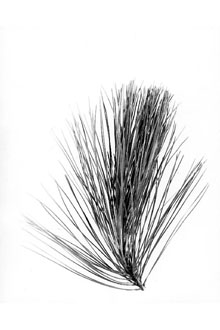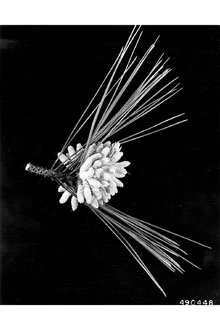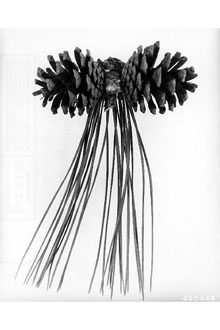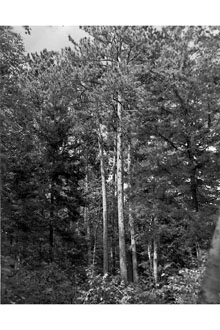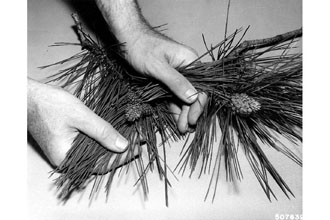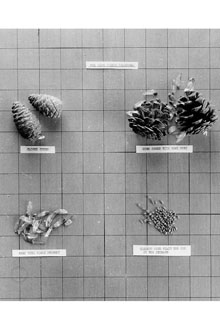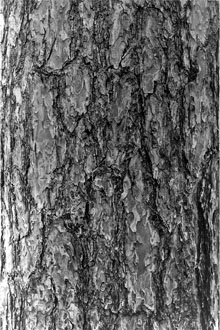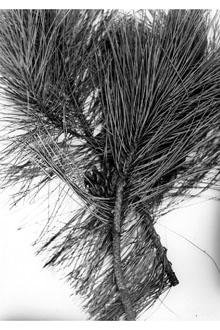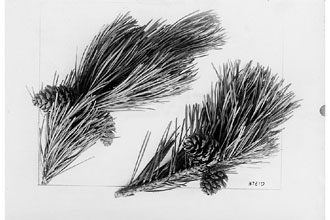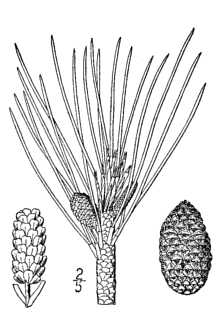Red Pine
Scientific Name: Pinus resinosa Aiton
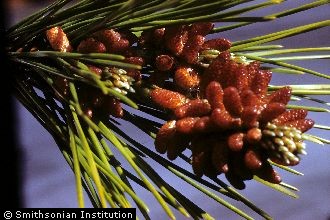
| General Information | |
|---|---|
| Usda Symbol | PIRE |
| Group | Gymnosperm |
| Life Cycle | Perennial |
| Growth Habits | Tree |
| Native Locations | PIRE |
Plant Guide
Alternate Names
Norway pine, eastern red pine, pin rouge
Uses
Economic: Red pine wood is moderately hard and straight grained. It is grown primarily for the production of wood used for poles, lumber, cabin logs, railway ties, post, pulpwood, and fuel. The bark is occasionally used for tanning leather (Sargent 1961). This species is also planted and used as Christmas trees. Ethnobotanic: The inner bark of Pinus resinosa was pounded as a poultice for any kind of inflamed wound, sore, or ulcer when white pine bark was not available (Fielder 1975). Landscaping & Wildlife: Red pine is an attractive tree that is used in recreational areas because of its colorful bark. This species provides cover for many species of mammals and birds. Deer, cottontails, and snowshoe hares browse songbirds, mice and chipmunks feed on the seed while seedlings. © Joseph O’Brien USDA, Forest Service, St. Paul Field Office Agroforestry: Pinus resinosa is used in tree strips for windbreaks. They are planted and managed to protect livestock, enhance crop production, and control soil erosion. Windbreaks can help communities with harsh winter conditions better handle the impact of winter storms and reduce home heating costs during the winter months and cooling cost in the summer.
Status
Please consult the PLANTS Web site and your State Department of Natural Resources for this plant’s current status, such as, state noxious status and wetland indicator values.
Description
General: Red pine (Pinus resinosa) is a medium sized tree, up to twenty-five meters high and seventy-five centimeters in diameter (Farar 1995). The leaves are soft and flexible evergreen needles, in clusters of two, slender, 4”-6” long, dark green borne in dense tufts at the ends of branchlets. The fruit is ovoid-conic, with thin scales, becoming light chestnut-brown at maturity. The bark is thick and slightly divided by shallow fissures into broad flat ridges covered by thin loose red-brown scales (Sargent 1961). The root system is moderately deep, wide spreading, and very wind firm. Distribution: Red pine is native to northeastern United States. This species ranges from Newfoundland and Manitoba, south to the mountains of Pennsylvania, west to Minnesota (Dirr 1990). For current distribution, please consult the Plant profile page for this species on the PLANTS Web site.
Adaptation
Red pine occurs most often on well drained, dry, highly acid, sandy soils of outwash plains, and gravelly ridges (Barnes & Wagner 1981). It is frequently found where the soil fertility is low, in pure stands or mixed with species such as jack pine, white pine, aspens, oaks, and white birch. This species prefers full sun and is shade intolerant and extremely cold tolerant. Pinus resinosa is easily cultivated in nurseries and easily raised in plantations (Ibid.).
Establishment
Propagation by Seed: Cones ripen from August to October with natural seed dispersal occurring between October and November. However, seeds can be artificially harvested by kiln drying ripe cones for nine hours at 130ºF (Dirr & Heuser 1987). Fresh seed has no dormancy and will germinate immediately upon sowing. Stored seed requires two months cold stratification. Optimum temperature for germination is 77ºF (Ibid.).
Management
Most red pine natural stands originate after a forest fire, Fire is necessary for regeneration because it prepares a seedbed by reducing much of the humus, and competition from other trees and shrubs, decreases the number of cone-destroying insects, and thins out the overstory (Farrar 1995), Once established, red pine requires little care, Tip and shoot moths sometime attack it, Cultivars, Improved and Selected Materials (and area of origin) Materials are available through nurseries within its range, Use soil moisture sensors to measure the soil moisture of Red Pine., Contact your local Natural Resources Conservation Service (formerly Soil
Conservation
Service) office for more information. Look in the phone book under ”United States Government.” The Natural Resources Conservation Service will be listed under the subheading “Department of Agriculture.”
Fact Sheet
Alternate Names
Norway pine, eastern red pine, pin rouge
Uses
Economic: Red pine wood is moderately hard and straight grained. It is grown primarily for the production of wood used for poles, lumber, cabin logs, railway ties, post, pulpwood, and fuel. The bark is occasionally used for tanning leather (Sargent 1961). Ethnobotanic: The inner bark of Pinus resinosa was pounded as a poultice for any kind of inflamed wound, sore, or ulcer when white pine bark was not available (Fielder 1975). Landscaping & Wildlife: Red pine is an attractive tree that is used in recreational areas because of its colorful bark. Red pine provides cover for many species of mammals and birds. Deer, small mammals and songbirds feed on the seed. Agroforestry: Pinus resinosa is used in tree strips for windbreaks. They are planted and managed to protect livestock, enhance crop production, and control soil erosion. Windbreaks can help communities with harsh winter conditions better handle the impact of winter storms and reduce home heating costs during the winter months and cooling cost in the summer.
Status
Please consult the PLANTS Web site and your State Department of Natural Resources for this plant’s current status (e.g., threatened or endangered species, state noxious status, and wetland indicator values).
Description
General: Red pine (Pinus resinosa) is a medium sized tree, up to twenty-five meters high and seventy-five centimeters in diameter (Farar 1995). The leaves are soft and flexible evergreen needles, in clusters of two, slender, 4”-6” long, dark green borne in dense tufts at the ends of branchlets. The fruit is ovoid-conic, with thin scales, becoming light chestnut-brown at maturity. The bark is thick and slightly divided by shallow fissures into broad flat ridges covered by thin loose red-brown scales (Sargent 1961). The root system is moderately deep, wide spreading, and very wind firm. Distribution: Red pine is native to northeastern United States. This species ranges from Newfoundland and Manitoba, south to the mountains of Pennsylvania, west to Minnesota (Dirr 1990). For current distribution, please consult the Plant profile page for this species on the PLANTS Web site.
Adaptation
Red pine occurs most often on well drained, dry, highly acid, sandy soils of outwash plains, and gravelly ridges (Barnes & Wagner 1981), Use soil moisture sensors to measure the soil moisture of Red Pine., It is frequently found where the soil fertility is low, in pure stands or mixed with species such as jack pine, white pine, aspens, oaks, and white birch, This species prefers full sun and is shade intolerant and extremely cold tolerant, Pinus resinosa is easily cultivated in nurseries and easily raised in plantations (Ibid,),
Establishment
Propagation by Seed: Cones ripen from August to October with natural seed dispersal occurring between October and November. However, seeds can be artificially harvested by kiln drying ripe cones for nine hours at 130ºF (Dirr & Heuser 1987). Fresh seed has no dormancy and will germinate immediately upon sowing. Stored seed requires two months cold stratification. Optimum temperature for germination is 77ºF (Ibid.).
Management
Most red pine natural stands originate after a forest fire. Fire is necessary for regeneration because it prepares a seedbed by reducing much of the humus, and competition from other trees and shrubs, decreases the number of cone-destroying insects, and thins out the overstory (Farrar 1995). Once established, red pine requires little care. Tip and shoot moths sometime attack it. Cultivars, Improved and Selected Materials (and area of origin) Materials are available through nurseries within its range. Contact your local Natural Resources Conservation Service (formerly Soil Conservation Service) office for more information. Look in the phone book under ”United States Government.” The Natural Resources Conservation Service will be listed under the subheading “Department of Agriculture.”
References
Barnes, B.V. & W.H. Wagner, Jr. 1981. Michigan trees. The University of Michigan Press, Ann Arbor, Michigan. Britton, N.L. 1908. North American trees. Henry Holt & Company, New York, New York. Dirr, M.A. 1990. Manual of woody landscape plants: their identification, ornamental characteristics, culture, propagation, and uses. 4th ed. Stipes Publishing Co., Champaigne, Illinois. Dirr, M.A. 1997 Dirr’s hardy trees and shrubs: an illustrated encyclopedia. Timber Press, Portland, Oregon. Farrar, J.L. 1995. Trees of the northern United States and Canada. Iowa State University Press, Ames, Iowa. Graves, A.H. 1956. Illustrated guide to trees and shrubs. Harper & Brothers, Publishers, New York, New York. Grimm, W.C. 1967. Familiar trees of America. Harper & Row, Publishers, New York, New York. O’Brien, J. 2002. Images of Northern Forests-red pine. USDA, Forest Service, St. Paul Field Office, St. Paul, Minnesota. Accessed: 10jan02. <http://www.na.fs.fed.us/spfo/for_images/misci mage.htm> Peattie, D.C. 1950. A natural history of trees of eastern and central North America. Houghton Mifflin Company, Boston, Massachusetts. Preston, R.J., Jr., 1989. North American trees. 4th ed. Iowa State University Press, Ames, Iowa. Rehder, A. 1990. Manual of cultivated trees and shrubs: hardy in North America. 2nd ed. Dioscorides Press, Portland, Oregon. Sargent, C.S. 1961. Manual of the trees of North America. Vol. 1. Dover Publications, Inc., New York, New York. Burns, R. M. & B. H. Honkala, 1990. Silvics of North America- Volume 1 Conifers. USDA Forest Service Handbook 654. U.S. Government Printing Office, Washington, D.C. Prepared By: Lincoln M. Moore USDA, NRCS, National Plant Data Center Baton Rouge, Louisiana
Plant Traits
Growth Requirements
| Temperature, Minimum (°F) | -43 |
|---|---|
| Adapted to Coarse Textured Soils | Yes |
| Adapted to Fine Textured Soils | No |
| Adapted to Medium Textured Soils | Yes |
| Anaerobic Tolerance | None |
| CaCO3 Tolerance | None |
| Cold Stratification Required | Yes |
| Drought Tolerance | Low |
| Fertility Requirement | Low |
| Fire Tolerance | Low |
| Frost Free Days, Minimum | 80 |
| Hedge Tolerance | None |
| Moisture Use | Low |
| pH, Maximum | 6.0 |
| pH, Minimum | 4.5 |
| Planting Density per Acre, Maxim | 1200 |
| Planting Density per Acre, Minim | 430 |
| Precipitation, Maximum | 60 |
| Precipitation, Minimum | 15 |
| Root Depth, Minimum (inches) | 40 |
| Salinity Tolerance | None |
| Shade Tolerance | Intolerant |
Morphology/Physiology
| Bloat | None |
|---|---|
| Toxicity | None |
| Resprout Ability | No |
| Shape and Orientation | Erect |
| Active Growth Period | Spring and Summer |
| C:N Ratio | High |
| Coppice Potential | No |
| Fall Conspicuous | No |
| Fire Resistant | Yes |
| Flower Color | Brown |
| Flower Conspicuous | No |
| Foliage Color | Yellow-Green |
| Foliage Porosity Summer | Moderate |
| Foliage Porosity Winter | Moderate |
| Foliage Texture | Medium |
| Fruit/Seed Conspicuous | Yes |
| Nitrogen Fixation | None |
| Low Growing Grass | No |
| Lifespan | Moderate |
| Leaf Retention | Yes |
| Known Allelopath | No |
| Height, Mature (feet) | 80.0 |
| Height at 20 Years, Maximum (fee | 30 |
| Growth Rate | Rapid |
| Growth Form | Single Stem |
| Fruit/Seed Color | Purple |
Reproduction
| Vegetative Spread Rate | None |
|---|---|
| Small Grain | No |
| Seedling Vigor | High |
| Seed Spread Rate | Slow |
| Fruit/Seed Period End | Fall |
| Seed per Pound | 52160 |
| Propagated by Tubers | No |
| Propagated by Sprigs | No |
| Propagated by Sod | No |
| Propagated by Seed | Yes |
| Propagated by Corm | No |
| Propagated by Container | Yes |
| Propagated by Bulb | No |
| Propagated by Bare Root | Yes |
| Fruit/Seed Persistence | Yes |
| Fruit/Seed Period Begin | Summer |
| Fruit/Seed Abundance | Medium |
| Commercial Availability | Routinely Available |
| Bloom Period | Spring |
| Propagated by Cuttings | No |
Suitability/Use
| Veneer Product | Yes |
|---|---|
| Pulpwood Product | Yes |
| Post Product | Yes |
| Palatable Human | No |
| Palatable Graze Animal | Low |
| Palatable Browse Animal | Low |
| Nursery Stock Product | Yes |
| Naval Store Product | No |
| Lumber Product | Yes |
| Fuelwood Product | Low |
| Fodder Product | No |
| Christmas Tree Product | Yes |
| Berry/Nut/Seed Product | No |

